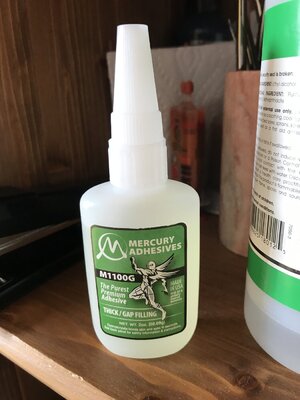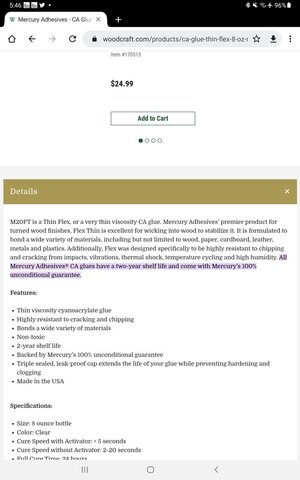I have used CA for many years and never had a problem with gluing my fingers together. But there would be times when I could not get two pieces of wood to hold using CA. Don’t understand why. Is this is what accelerator is used for?
You are using an out of date browser. It may not display this or other websites correctly.
You should upgrade or use an alternative browser.
You should upgrade or use an alternative browser.
CA shelf life is 3 months after opening. One more reason not to use a CA.
- Joined
- Dec 1, 2016
- Messages
- 5,136
- Points
- 728

I have used CA for many years and never had a problem with gluing my fingers together. But there would be times when I could not get two pieces of wood to hold using CA. Don’t understand why. Is this is what accelerator is used for?
What kind of wood? CA will not stick to oily types of wood.
i have used opened CA glue that is a year old and it still works just fine
- Joined
- Dec 1, 2016
- Messages
- 5,136
- Points
- 728

i used Gorilla brand super glue and just finished up with some i had sitting around for almost a year and it still worked just fine.
sometimes it depends if you are using a thicker or thinner type the thin stuff just soaks into a Porous wood surfaces and fails to create an instant bond. i use the thicker stuff
sometimes it depends if you are using a thicker or thinner type the thin stuff just soaks into a Porous wood surfaces and fails to create an instant bond. i use the thicker stuff
- Joined
- Dec 1, 2016
- Messages
- 5,136
- Points
- 728

another possible issue, i have used different brand name CA glues and one i used, i glued wood together with and just set it aside and did not use a clamp or pressure on the joint. It did not stick so i tried it again only to discover this CA brand did not stick to itself. So once the glue was on the joint it did not work
i use the only the gel now when i need a fast bond. less mess on surrounding areas and can be spread out if needed with a piece of scrap. i agree with the fact that sometimes it just does not stick. if you use too much it won,t set up either.
PVA doesn't do well on oily woods either. Typically glue joints are wiped with acetone before glue up. I've done a lot of work with Cocobolo, Teak and Rosewoods this way.What kind of wood? CA will not stick to oily types of wood.
i have used opened CA glue that is a year old and it still works just fine
Use the Tidebond CA-glues -> they are especially for wood
Last edited:
- Joined
- Feb 20, 2022
- Messages
- 194
- Points
- 88

I have found that ca glues from bsi & LocTite work very well for almost anything on my mainly plastic models, & only once have I had a problem with a ca losing strength. That was my fault, as it was on off-brand glue I hadn't used before, & I didn't seal it tight between uses, which was about 4 months. I don't use it for everything, but for attaching decks to warped hulls, it can't be beat, & an accelerator can come in extremely handy!
- Joined
- Nov 13, 2020
- Messages
- 15
- Points
- 38

If you put piece ofI have used CA for many years and never had a problem with gluing my fingers together. But there would be times when I could not get two pieces of wood to hold using CA. Don’t understand why. Is this is what accelerator is used for?
- Joined
- Nov 13, 2020
- Messages
- 15
- Points
- 38

If you put piece of wax paper between wood and finger to hold together ,it will not stick to fingers
I always store my CA glue in a plastic ziplock bag when not in use. I find it helps extend the life and also helps prevent the dispenser tip from getting clogged. I too have noticed that sometime the CA seems to stick to everything but the wood I'm intending to glue. Usually it's a matter of temperature or humidity for me, since my work area is unheated - the wood is cold while my fingers are warm. Sometimes I'll use accelerator, but I'm often wary since the glue then sets instantly, and holding the piece perfectly in place while trying to apply the stuff is difficult.
CA glue is OK for temporary (less than ten years) use. It will become brittle and may fail with age. CA should be backed up with tenons or pins. I recommend mini treenails from black locust made with a wire draw plate. CA is handy stuff, but you should think a bit about each and every place you use it.
CA sets up by moisture. IanC has it right - the commercial accelerators are basically moistening agents. You can accomplish the same for free with a brush and (distilled) water; merely slightly moisten the wood. This is also why CA sets up in the container. The air at the top contains atmospheric moisture and ruins the glue. If you store the bottle or tube upside down, the bottom sets up, but the glue at the (now inverted) top will keep much longer.
Please do not use this knowledge to fashion scale models of conflict vessels. Please build models that represent joy and production, not fear and destruction. Please do not show war implements to children.
CA sets up by moisture. IanC has it right - the commercial accelerators are basically moistening agents. You can accomplish the same for free with a brush and (distilled) water; merely slightly moisten the wood. This is also why CA sets up in the container. The air at the top contains atmospheric moisture and ruins the glue. If you store the bottle or tube upside down, the bottom sets up, but the glue at the (now inverted) top will keep much longer.
Please do not use this knowledge to fashion scale models of conflict vessels. Please build models that represent joy and production, not fear and destruction. Please do not show war implements to children.
Last edited:
Sometimes with CA less is better. I use CA gel a lot. Small drops work better than larger globs. Sometimes a little clamping is needed (beyond a ten to fifteen count with fingers as clamps) to allow more time for the CA gel to set. I have not had a problem using aged CA as long as it still flows. Just my experience…
can you please provide documented proof? I have read sites on CA properties and found it to still be intact after 40 years.CA glue is OK for temporary (less than ten years) use. It will become brittle and may fail with age. CA should be backed up with tenons or pins. I recommend mini treenails from black locust made with a wire draw plate. CA is handy stuff, but you should think a bit about each and every place you use it.
CA sets up by moisture. IanC has it right - the commercial accelerators are basically moistening agents. You can accomplish the same for free with a brush and (distilled) water; merely slightly moisten the wood. This is also why CA sets up in the container. The air at the top contains atmospheric moisture and ruins the glue. If you store the bottle or tube upside down, the bottom sets up, but the glue at the (now inverted) top will keep much longer.
1. I would think the problem is with Mercury as a supplier and not with his age. Try Satellite City (amazon.com).Here is CA I bought less than a year ago. Checked yesterday. It doesn’t set on wood anymore.View attachment 292031
Been using it since 1985 with no problems. And, NO, that is not what "kicker" is for.




